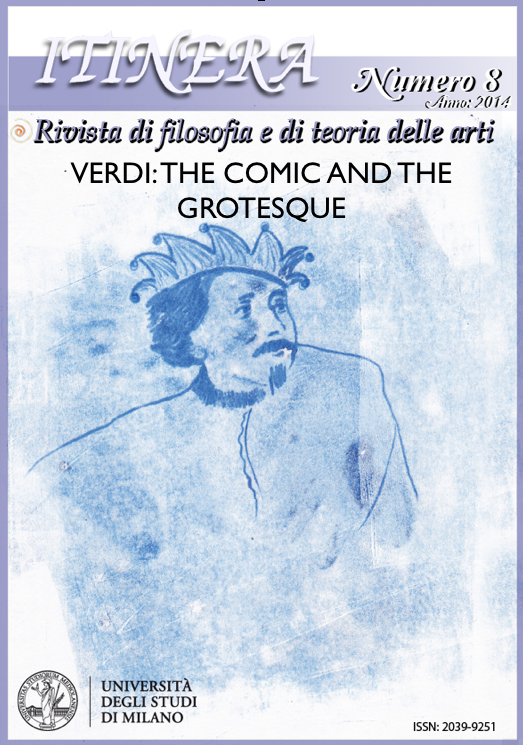Victor Hugo e il fou du roi: variazioni su un tipo
DOI:
https://doi.org/10.13130/2039-9251/4599Abstract
In the Victorian theatre the buffoon is a central character for more than one reason. He contributes to the historical contextualization of the drama and to that principle of historical reconstruction, which is essential to the romantic theatre. Moreover, this character is part of that search for spectacularity, which is equally one of the most relevant aspects of Hugo’s theatre. Finally, the buffoon is also one of the most typical incarnations of the grotesque, which is a fundamental principle of Hugo’s theatrical poetics. This paper realizes a transversal and comparative reading of some of Hugo’s dramas (Cromwell, Marion Delorme, Le roi s'amuse), with the aim of reconstructing an overall picture of the dramatic type of the buffoon and its evolution, also showing its effects in the work of Verdi.
Riferimenti bibliografici
ABBIATI, Franco, Giuseppe Verdi, Ricordi, Milano 1959.
CARRIQUE, Noémi, “Les bouffons du ‘roi manqué’. Rôles des quatre fous dans Cromwell”, in Groupe Hugo, 16 ottobre 2013 [on line]. Disponibile all’indirizzo : http://groupugo.div.jussieu.fr/groupugo/Cromwell/Carrique_%20Les%20bouffons%20du%20roi%202013_10_16.pdf
FÉVAL, Paul, Le bossu (1857), Le Livre de Poche, Paris 1997.
HUGO, Victor, Bug-Jargal, Le Dernier jour d’un condamné, Claude Gueux, Nelson, Paris s.d.
—, Théâtre complet, a cura di J. Mélèze e di J.-J. Thierry, Gallimard, Paris 1964.
—, Notre-Dame de Paris, Garnier Flammarion, Paris 1967.
—, Sul Grottesco (1827), tr. it. di M. Mazzocut-Mis, Guerini, Milano 1990.
—, Théâtre en liberté, a cura di A. Laster, Gallimard, Paris 2002.
IOTTI, Gianni, “Le metamorfosi di Triboulet”, in M. Streiff Moretti, M. Revol Cappelletti, O. Martinez (a cura di), Il senso del nonsenso, Edizioni scientifiche italiane, Napoli 1994, pp. 295-312.
LACROIX, Paul, Les deux fous. Histoire du temps de François Ier (1830); Martinon, Paris 1845.
LAMBERT, Françoise, Le manuscrit du Roi s’amuse, Presses de l’Université de Besançon, Paris 1966.
LEVER, Maurice, Le sceptre et la marotte: histoire des fous de la cour, Fayard, Paris 1983.
MAZOUER, Charles, “Le tragique dans Le roi s’amuse et Lucrèce Borgia”, Revue française d’histoire du livre, 58-59, 1988, pp. 237-255.
PERRIN, Francis, Le bouffon des rois, Plon, Paris 2011.
PREVOST, Maxime, Rictus romantiques. Politiques du rire chez Victor Hugo, Presses de l’Université de Montréal, Montréal 2002.
RONZEAUD, Pierre, “Du ‘plaisant’ burlesque au bouffon ‘grotesque’: Scarron/Hugo”, in R. Galli Pellegrini, I. Merello, F. Robello, S. Poli (a cura di), La Guirlande de Cecilia, Schena, Fasano 1996, pp. 317-332.
STEGMANN, André, “Sur quelques aspects des fous en titre d’office dans la France du XVIe siècle”, in Folie et déraison à la Renaissance, Editions de l’Université de Bruxelles, Bruxelles 1976, pp. 53-68.
UBERSFELD, Anne, Le Roi et le Bouffon. Etude sur le théâtre de Hugo (1974), Corti, Paris 2001.
VERDI, Giuseppe, Autobiografia dalle lettere (1941), a cura di A. Oberdofer, Rizzoli, Milano 1981.
Dowloads
Fascicolo
Sezione
Licenza
Gli autori che pubblicano su questa rivista accettano le seguenti condizioni:
1. Gli autori mantengono i diritti sulla loro opera e cedono alla rivista il diritto di prima pubblicazione dell'opera, contemporaneamente licenziata sotto una Licenza Creative Commons - Attribuzione - Condividi allo stesso modo 4.0 internazionale che permette ad altri di condividere l'opera indicando la paternità intellettuale e la prima pubblicazione su questa rivista.
2. Gli autori possono aderire ad altri accordi di licenza non esclusiva per la distribuzione della versione dell'opera pubblicata (es. depositarla in un archivio istituzionale o pubblicarla in una monografia), a patto di indicare che la prima pubblicazione è avvenuta su questa rivista.
3. Gli autori possono diffondere la loro opera online (es. in repository istituzionali o nel loro sito web) prima e durante il processo di submission, poiché può portare a scambi produttivi e aumentare le citazioni dell'opera pubblicata (Vedi The Effect of Open Access).





